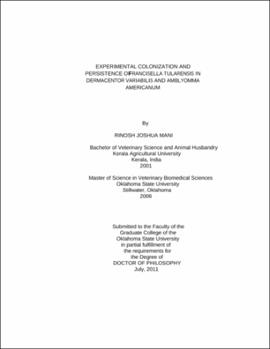| dc.contributor.advisor | Clinkenbeard, Kenneth D. | |
| dc.contributor.author | Mani, Rinosh Joshua | |
| dc.date.accessioned | 2013-11-26T08:35:16Z | |
| dc.date.available | 2013-11-26T08:35:16Z | |
| dc.date.issued | 2011-07 | |
| dc.identifier.uri | https://hdl.handle.net/11244/7666 | |
| dc.description.abstract | Francisella tularensis causes tick-transmitted tularemia epizootics in rodent and rabbit hosts and incidental infections in humans. The objective of this study was to develop a F. tularensis tick colonization model for elucidating the salient features of its biology in tick vectors. The first two studies reported herein describe the systematic study of F. tularensis ssp. holarctica strain LVS colonization in the tick vectors Dermacentor variabilis and Amblyomma americanum as well as describing the capillary feeding (CF) method of colonizing the different stages of these ticks. Post capillary feeding (PCF), level of colonization was determined by CFU determinations of tick minceate. Transmission of F. tularensis from larvae to nymph was seen in both tick species, but only A. americanum nymphs maintained F. tularensis for longer periods of time (168 days PCF). Transstadial transmission from nymph to adult was also demonstrated in both the tick species, but only D. variabilis ticks maintained F. tularensis colonization after molting from nymphs to adults. For CF adults, F. tularensis initial colonization of the gut disseminated to hemolymph and salivary glands in three weeks and 24 h PCF for D. variabilis and A. americanum respectively. Colonization of adult D. variabilis ticks persisted up to 6 months PCF (longest time point in study). Transovarial transmission was not observed in either tick species. However, colonized D. variabilis adult females transferred F. tularensis to surface layer of eggs but not to hatched larvae. The extrinsic incubation period (time to secretion in saliva), determined by intra-hemocel injection of F. tularensis in D. variabilis and A. americanum was 4 and 2 days, respectively. The ID50 for mice for intraperitoneal injection of F. tularensis from adult D. variabilis salivary glands versus laboratory culture F. tularensis were 2 and 43 CFU, respectively. Both tick species appear competent as experimental vectors for F. tularensis with D. variabilis adults and A. americanum nymphs better adapted for long term persistence of F. tularensis. The role of these ticks as a possible inter-epizootic reservoir of F. tularensis is also discussed. The final chapter of this dissertation addresses the possible role of chitin as a nutrient source for F. tularensis in the tick life cycle. | |
| dc.format | application/pdf | |
| dc.language | en_US | |
| dc.rights | Copyright is held by the author who has granted the Oklahoma State University Library the non-exclusive right to share this material in its institutional repository. Contact Digital Library Services at lib-dls@okstate.edu or 405-744-9161 for the permission policy on the use, reproduction or distribution of this material. | |
| dc.title | Experimental colonization and persistence of Francisella tularensis in Dermacentor variabilis and Amblyomma americanum | |
| dc.contributor.committeeMember | Reichard, Mason V. | |
| dc.contributor.committeeMember | Morton, Rebecca J. | |
| dc.contributor.committeeMember | Kocan, Katherine M. | |
| dc.contributor.committeeMember | Shaw, Edward I. | |
| osu.filename | Mani_okstate_0664D_11470 | |
| osu.accesstype | Open Access | |
| dc.type.genre | Dissertation | |
| dc.type.material | Text | |
| dc.subject.keywords | Francisella tularensis | |
| dc.subject.keywords | inter-epizootic reservoir | |
| dc.subject.keywords | ticks | |
| dc.subject.keywords | transovarial transmission | |
| dc.subject.keywords | transstadial transmission | |
| thesis.degree.discipline | Veterinary Pathobiology | |
| thesis.degree.grantor | Oklahoma State University | |
